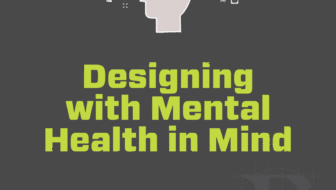Designing with Mental Health in Mind: Architecture & the Influence of the Built Environment
Chances are one of your loved ones, friends, or colleagues has been affected by mental illness. Perhaps you’ve struggled with mental illness yourself. According to the National Alliance on Mental Illness (NAMI), about 1 in 5 adults experience mental illnesses each year, and 1 in 6 youth aged 6-17 experience a mental health disorder each year. Arguably, an even more staggering figure is that less than half of those individuals receive care, and if they do seek treatment, the average delay between onset of mental illness symptoms and treatment is 11 years.1 The Mayo Clinic suggests that reluctance to seek help or treatment can be due to the harmful effects of mental health stigma, or negative attitudes and beliefs toward people who have a mental health condition.2
Aside from simply supporting organizations and individual efforts to raise public awareness, break down stigma barriers, and advocate for mental health care; what design decisions and other steps can be taken to support positive mental health in society every day?
It may seem unlikely, but architects are uniquely positioned to help address many of the chronic health challenges our society faces today. Architecture does more than provide shelter or practical spaces for human activities, although that is one aspect. The purpose of architecture can also be recognized as design to improve human life by creating a more livable and sustainable built environment. As people interact daily with their physical surroundings, the built environment has the ability to heighten stress or help people cope with it. From asthma to obesity, and diabetes to depression, a growing body of practice-based evidence is clearly demonstrating the profound impact that forward-looking design decisions can have on human health for individuals and communities.3
Promoting Health & Wellness in Architecture
The American Institute of Architects (AIA) recognizes health as one of its priorities for advancing the field of architecture, affirming that licensed architects and affiliated design professionals have, in their professional practice, a positive duty to protect the public’s health, safety, and welfare.4 The AIA defines Health aspects as those that improve the physical, emotional, and social well-being of occupants, users, and any others affected by buildings and sites; while Safety aspects are those that protect occupants, users, and any others affected by buildings or sites from harm; and Welfare aspects enable equitable access, elevate the human experience, encourage social interaction, and benefit the environment.4
Andrew Dannenberg and Heather Burpee pose the question of why architects should care about health beyond what they are already doing in Architecture for Health Is Not Just for Healthcare Architects. By focusing on the health-promoting aspects of design, architects have the opportunity to contribute to solutions to major societal challenges, to lead change, to improve the quality of life for everyone, and to grow the demand for their services.5
According to the World Health Organization, mental health promotion should include actions that create living conditions and environments that support mental health and allow people to adopt and maintain healthy lifestyles6 — and that’s where architecture comes in. Dannenberg and Burpee note, “Architecture can heighten our everyday experience from the dull to the spectacular and can comfort, elevate, and delight people…It can create order and inspiration out of building materials that then provide order and inspiration for human activities. Implicit in these goals is the ability of design to influence the physical and mental health of the people who live, work, and play in the environments created by architects.”5
Designing for a Better Mental-Scape
The AIA, in cooperation with experts in design, health, and policy, have developed six evidence-based approaches that designers can use to promote overall health and well-being. Included in those approaches are the themes of environmental quality, natural systems, physical activity, safety, sensory environments, and social connectedness.3 These approaches lay the groundwork for design factors that should be considered when designing specifically for mental wellness. In his book, Happy by Design: A Guide to Architecture and Mental Wellbeing, author Ben Channon summarizes key concepts that designers have in their toolkit to help support people’s mental wellbeing through the buildings they create.7 A number of Channon’s tips, and a few of our own include:
- Ensure both quality and quantity of light are provided, suitable for each space’s purpose
- Consider touch and sound when designing, not just sight
- Design with the mindset that buildings should enable rather than inhibit their users
- Involve plants, water, and wildlife wherever possible
- Use the aesthetics of design to create visual interest and joy
- Use color selectively to support mood
- Encourage building users to be active
- Provide calm spaces for escape and relaxation
- Provide generous storage
- Make spaces open and airy, but designed for human scale
- Make buildings comfortable spaces in which to spend time
- Create a sense of home
By most estimations, 80% of our time is spent in buildings, and this can affect our mood both positively and negatively. Those social, cultural, and environmental influences, or psychosocial factors, in the places where we live, work, and study, therefore impact our happiness significantly. “Happiness is an incredibly important but often overlooked aspect of our lives,” says Channon. It can result in improved productivity in the workplace and better learning in students; and most importantly, it can drastically improve people’s quality of life and physical and mental health.”7
Paragon Architecture’s New Headquarters Demonstrates Design for Overall Health & Wellness
From large collaboration spaces to intimate nooks that allow for a mental retreat, Paragon’s new downtown headquarters in Springfield, Missouri was thoughtfully designed. With the productivity and well-being of end-users in mind, Paragon utilized each of the tips just discussed in the renovation of their HQ. The use of windows and skylights allow natural light to permeate the entire space, while tropical plants line the office and help to bring natural elements indoors. Paragon’s signature green accent color is splashed on select interior walls and original architectural features of the renovated space for an instant mood-booster. The coffee bar and full-size kitchen certainly create a sense of home, while the wellness room, fitness area, and adjustable-height desks encourage users to be active.
President and principal architect of Paragon Architecture, Brad Erwin notes that while thinking about Paragon’s new space and when designing any new facility, one of the goals is to provide multiple types of places for people to work. “We wanted the ability to move between completely different settings,” he says. “Whether that’s eight people around a conference table, three or four people in a quiet room with some soft seating where they can sit and collaborate, or a quiet nook for someone to avoid all distractions and take a call.”8
The physical space now promotes employees’ positive mental health while providing support for the overall company culture. Studies show that a positive workplace culture attracts talent, drives engagement, impacts employees’ happiness and satisfaction and affects performance. Paragon’s Wellness Coordinator, Beth Keeling, reflects on transitioning from a small and limiting space. “We learned very quickly that our new environment allows each person room to think, to breathe and to be. This has a substantial impact on wellbeing and balance. Some spend their day working on the patio soaking up the sun and essentially recharging their batteries. Others work from a library filled with vibrant colors and space to truly create. We’re all fueled and inspired in unique ways and this building reflects that.”
How Powerful is Design as a Preventative Measure?
In an interview with Well Home Magazine, author of Rethinking Mental Health in Architecture, Ben Channonsays, “We have to be realistic. Good architecture isn’t going to provide magical cures to people with severe mental health problems – this is a fact. Architecture won’t replace the amazing advances being made in science and medicine. But by providing comfortable, well-designed spaces where people feel happy and safe, we can improve the day to day happiness of people who use them, which – in my opinion – is a powerful way of keeping people in a better mental place”.9
Like Channon, I can attest that there is a noticeable difference in my own mental well-being and positivity after working in an environment that encourages mental wellness, versus working in an unpleasant environment with constant stressors. Stress often develops from familiar elements such as work, school, financial stability, and even traffic. While we cannot eliminate stress completely from our lives, we can try to learn how to minimize it in the built environment before it develops into depression, anxiety, and other more serious mental illnesses.10
Time to Take Action
Mental health awareness is growing, and along with it, so is the opportunity to take preventative measures.
At Paragon, we partner with schools, municipalities, corporations, and health centers again and again, because we recognize that community partnerships lead to enrichment in the lives of our citizens. We recognize that architecture is a factor in the mental health landscape, and we have an opportunity to make an impact today for a better tomorrow. So whether you are looking to create your district’s next collaborative learning environment for students, a workspace that fosters both personal and professional growth of employees, or a civic facility or health center that answers the call in your community — when you are ready to talk about your next project, give us a call and we’ll take action together. Our architects and interior designers are passionate project managers, ready to advocate your vision from the first sketch to your final phone call—and beyond. Ready to learn more? Contact our team.
References
1 National Alliance of Mental Health (NAMI): Mental Health By the Numbers. Retrieved from: https://www.nami.org/mhstats (accessed on 25 August 2020).
2 Mayo Clinic. (2017). Mental health: Overcoming the stigma of mental illness. Retrieved from : https://www.mayoclinic.org/diseases-conditions/mental-illness/in-depth/mental-health/art-20046477 (accessed on 21 August 2020).
3 American Institute of Architects. (2018). AIA’s design and health initiative. Retrieved from https://www.aia.org/pages/3461-aias-design-health-initiative (accessed on 21 August 2020).
4 American Institute of Architects. (2018). Health, safety and welfare credits. Retrieved from https://www.aia.org/pages/3281-health-safety-and-welfare-credits (accessed on 21 August 2020).
5 Dannenberg, A. L., & Burpee, H. (2018). Architecture for Health Is Not Just for Healthcare Architects. HERD: Health Environments Research & Design Journal, 11(2), 8–12. https://doi.org/10.1177/1937586718772955
6 World Health Organization (WHO). (2020). Mental Health: Strengthening Our Response. Retrieved from : http://www.who.int/mediacentre/factsheets/fs220/en/ (accessed on 21 August 2020).
7 Channon, B. (2019). Happy By Design. 1st ed. Milton: RIBA Publications.
8 Springfield Business Journal. (2020). Future Workforce, Operations Top New Space Concerns. Springfield Business Journal. Available online: https://sbj.net/stories/future-workforce-operations-top-new-space-concerns,68130?
9 Well Home. (2019) Architecture And Mindfulness: Ben Channon (Q1, 2019): 148-152. Available online: https://www.wellhomeglobal.com/people/Ben-Channon/33190
10 McClure, E. (2020). “Empirical Empowerment – Mental Health in the Built Environment.” Bachelor of Architecture Theses – 5th Year. 119. Available online: https://digitalcommons.kennesaw.edu/barch_etd/119



